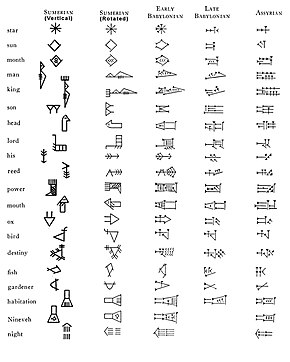Cuneiform
| Cuneiform | |
|---|---|
 Trilingual cuneiform inscription of Xerxes I at Van Fortress in Turkey, written in Old Persian, Elamite and Babylonian forms of cuneiform | |
| Script type | Logographic
and syllabary |
| Created | around 3200 BC[1] |
Time period | c. 31st century BC to 2nd century AD |
| Direction | left-to-right |
| Languages | Sumerian, Akkadian, Eblaite, Elamite, Hittite, Hurrian, Luwian, Urartian, Old Persian, Palaic |
| Related scripts | |
Parent systems | (Proto-writing)
|
Child systems | None; influenced the shape of Ugaritic and Old Persian glyphs |
| ISO 15924 | |
| ISO 15924 | Xsux, 020 |
| Unicode | |
Unicode alias | Cuneiform |
Unicode range |
|
Cuneiform[note 1] is a logo-syllabic script that was used to write several languages of the Ancient Near East.[4] The script was in active use from the early Bronze Age until the beginning of the Common Era.[5] It is named for the characteristic wedge-shaped impressions (Latin: cuneus) which form its signs. Cuneiform originally developed to write the Sumerian language of southern Mesopotamia (modern Iraq). Along with Egyptian hieroglyphs, it is one of the earliest writing systems.
Over the course of its history, cuneiform was adapted to write a number of languages linguistically unrelated to Sumerian. Akkadian texts are attested from the 24th century BC onward and make up the bulk of the cuneiform record.[6][7] Akkadian cuneiform was itself adapted to write the Hittite language sometime around the 17th century BC.[8][9] The other languages with significant cuneiform corpora are Eblaite, Elamite, Hurrian, Luwian, and Urartian.
The latest known date for a cuneiform tablet is 75 AD.[10] The modern study of cuneiform writing begins with its decipherment in the mid-19th century, and belongs to the field of Assyriology. An estimated half a million tablets are held in museums across the world, but comparatively few of these are published. The largest collections belong to the British Museum (approx. 130,000 tablets), the Vorderasiatisches Museum Berlin, the Louvre, the Istanbul Archaeology Museums, the National Museum of Iraq, the Yale Babylonian Collection (approx. 40,000 tablets), and Penn Museum.[11]
History[]

The origins of writing appear during the start of the pottery phase of the Neolithic, when clay tokens were used to record specific amounts of livestock or commodities.[14] These tokens were initially impressed on the surface of round clay envelopes and then stored in them.[14] The tokens were then progressively replaced by flat tablets, on which signs were recorded with a stylus. Actual writing is first recorded in Uruk, at the end of the 4th millennium BC, and soon after in various parts of the Near-East.[14]
An ancient Mesopotamian poem gives the first known story of the invention of writing:
Because the messenger's mouth was heavy and he couldn't repeat [the message], the Lord of Kulaba patted some clay and put words on it, like a tablet. Until then, there had been no putting words on clay.
The cuneiform writing system was in use for more than three millennia, through several stages of development, from the 31st century BC down to the second century AD.[17] Ultimately, it was completely replaced by alphabetic writing (in the general sense) in the course of the Roman era, and there are no cuneiform systems in current use. It had to be deciphered as a completely unknown writing system in 19th-century Assyriology. Successful completion of its deciphering is dated to 1857.
|
The cuneiform script underwent considerable changes over a period of more than two millennia. The image below shows the development of the sign SAĜ "head" (Borger nr. 184, U+12295 WIKI |


